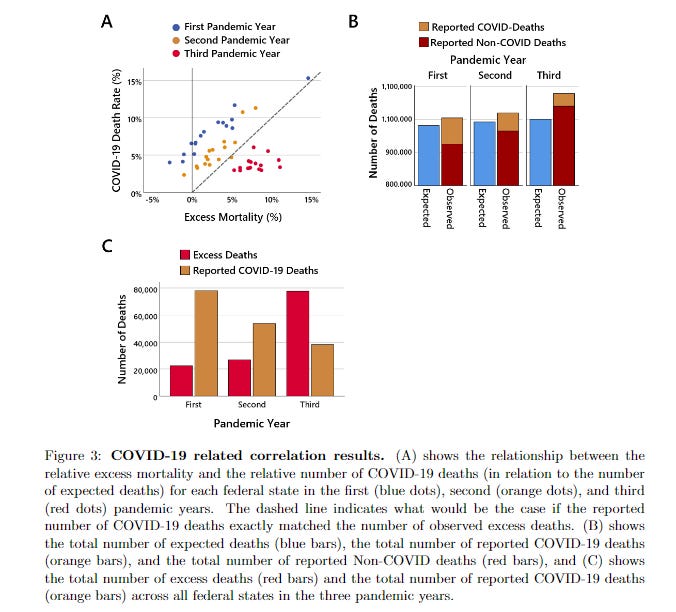German Study Finds Strong Correlation Between Excess Deaths, Stillbirths and Vaccination
Plus lockdowns had zero effect.
A new preprint by Christof Kuhbandner from Regensburg University and Matthias Reitzner from Osnabruck University in Germany, investigates the influence of COVID-19 on mortality in sixteen German federal states. To do this they estimated state-specific excess mortalities for 2020-2021, 2021-2022 and 2022-2023 and compared them with the strength of measures, COVID-19 infections and vaccination rates, as well as aspects unrelated to the pandemic, including age, wealth, poverty and people in care.
The authors note a surprising pattern that has also occurred in many other countries - whilst 2020 only saw a minor rise in excess deaths, this drastically shot up in 2021 and doubled in 2022.
To try and understand what caused the huge rise in excess deaths, the authors looked at several key state-specific quantities. The first place they looked was at COVID-19 deaths and infections. They found that in the first two pandemic years there was a strong correlation between excess deaths and the reported numbers of COVID-19 deaths and infections.
The charts above show that reported COVID-19 deaths were two times higher than the number of observed excess deaths meaning that the reported number of COVID-19 deaths significantly overestimated the burden of COVID-19 on mortality. They estimate that the true excess mortality caused by COVID-19 was along the same scale as previous strong flu waves, such as the flu season in 2017/18.
Along comes the third year of the pandemic and the picture fundamentally changes. Suddenly the correlation between COVID-19 and excess deaths largely disappears. “It is already becoming apparent in the second pandemic year that an additional factor is beginning to contribute to excess mortality.”
So they decided to look at the correlation between excess deaths and vaccination.
They say that at first glance you may be tempted to interpret the findings as evidence of vaccine effectiveness. But why would the pattern in the second year be exactly the same as the first, when there was no vaccination? Instead, the “correlation seems to stem from the fact that vaccination rates were highest in the federal states that were least affected by COVID-19”.
“If the vaccinations were effective, the federal states with the highest vaccination rates would have benefited the most, which means that the correlations between vaccinations and mortality observed in the first year of the pandemic should have been even more negative in the second year of the pandemic, which is not the case.”
This is further supported by these charts which show the increase in excess mortality from the first to the second year of the pandemic and the first to the third year.
The charts show that, in the second pandemic year, there is a moderately strong positive correlation between excess deaths and vaccination rates but this turns into a strong correlation by the third year.
What’s more, if you look back at chart 4c above, the correlation pattern for COVID-19 infections also changes in year three - the exact opposite of what you would expect with an effective vaccination.
The authors try to find a third variable to explain this correlation but cannot find one.
The fact that the increase in excess mortality in the second year of the pandemic is correlated both temporally and spatially with the number of vaccinations administered suggests that this new excess mortality factor could be the vaccinations. This hypothesis is further strengthened empirically by the fact that a highly positive correlation between vaccination rate and excess mortality is observed in the third pandemic year, suggesting a long-lasting negative effect of the vaccinations.
One such third variable could be some of the draconian measures taken, such as lockdowns. However, the study did not find a single correlation with regard to the strength of the measures taken and excess deaths, COVID-19 deaths or infections.
The fact that not a single significant correlation was observed in any of the three pandemic years between the measures taken against COVID-19 and the number of COVID-19 deaths and infections makes it seem unlikely that the measures taken had any effect but only have produced statistical noise.
The study also looked at stillbirths and found a similar pattern to that for excess mortality.
The authors conclude that the only two quantities that showed a strong correlational relationship with observed excess mortality were COVID-19 and vaccination rates. By the second and third years of the pandemic, the more vaccinations that were administered in a federal state, the greater the increase in excess mortality. “The fact that particularly high excess mortality occurs both in regions and in time windows in which many vaccinations took place provides strong correlational evidence that the vaccinations may have had a negative effect instead of a positive effect”.










And here I was, just returned from looking fondly at the basil and radishes growing happily in the sunlight beaming onto my windowsill and this post smacks awake the rage and frustration I feel whenever I remember my UK friend murdered by the vax. It's not like I don't remember her every day but I try to think of the happy times of which there had been so many.
At least we know what was done to us. Those mourners of the young soldiers killed during the Spanish Flu epidemic by hearty doses of aspirin that blew their lungs to smithereens, they thought it was just cruel fate, a Black Death for their times.
We should be sure to not waste the knowledge given to us by researchers and reporters like you.
They will probably retract it. Wait a year or so.